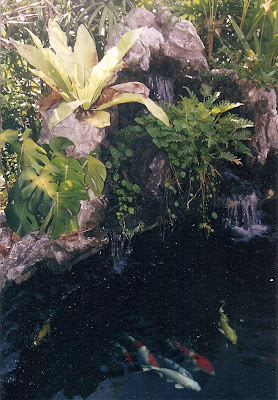The layout is that of an informal pond since the idea is to create a garden and natural setting in my backyard. In my country, most Koi ponds are built using reinforced concrete. The walls are vertical, as in most concrete Koi ponds.

The water return from the filtration system is through a large waterfall falling into the main Koi pond (shown on the left photo).
A second return is through a smaller “waterfall” feeding into the smaller, shallower pond which was to keep water plants and act as a vegetation/plant filter (shown below). The smaller water-garden pond overflows into the main Koi pond with a drop of about 20 mm.

Besides creating a nice, soothing sound of gurgling water, the waterfalls are a good form of aeration for the Koi pond. Planting around the waterfall soften the overall look and adds to the natural garden effect.
3 venturi pipes are included in the water return system, serving to further aerate the pond. The pipes are arranged to circulate water slowly in a clockwise direction around the pond which is supposed to be good for Koi and moves dirt and debris in the pond towards the bottom drains.
The pond depth is about 1 m from the ground. The actual water level is 0.85 m from bottom of pond. This is shallower than the ideal depth for Koi but I need to take into consideration the overall size of the pond for a balanced proportion.
Two 100mm diameter bottom drains are provided in the main Koi pond. A removable wire mesh covers each bottom drain. For filter maintenance, I remove the wire mesh, stick in a standpipe and I can flush the filter with lesser water lost through the bottom drains (note: water is still lost by backflow into the filter through the venturi pipes once the pumps are turned off and water level in the filter is lowered!)
A surface skimmer through a 50 mm diameter pipe that feeds into the filter removes surface debris, oil and surface scum. A short, removable standpipe is used to close this skimmer during feeding. A better solution, without need for a removable standpipe, was used for my second pond.
A 50mm diameter overflow pipe, leading to the drain, is provided in the main pond. This is especially needed in Singapore where several inches of heavy rainfall is common during the monsoon season.
Pumps used for the main ponds are Nova 600 (800 W, 3.4A, 16 cubic m/hr, Power consumption/month = 584 KWH) and Nova 200 (350 W, 1.5A, 12 cubic m/hr, Power consumption/month = 250 KWH). I used another Nova 200 for the drain pump. The Nova 600 supplies water to the main waterfall. The Nova 200 drives water to the small pond and also drives one of the venturi pipes. Most of the time, I just operated one 2 Nova 200 pumps. I turned on the Nova 600 (waterfall pump) only when I am spending time in the garden. Guideline is that the entire pond water should be circulated at least twice through the filter per hour.
No comments:
Post a Comment